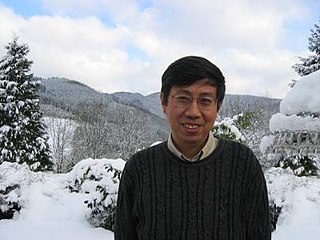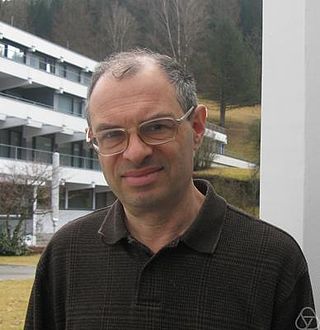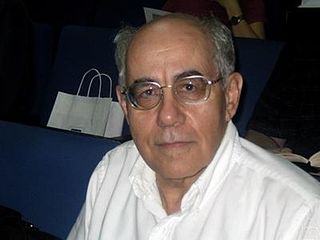In mathematics, complex geometry is the study of geometric structures and constructions arising out of, or described by, the complex numbers. In particular, complex geometry is concerned with the study of spaces such as complex manifolds and complex algebraic varieties, functions of several complex variables, and holomorphic constructions such as holomorphic vector bundles and coherent sheaves. Application of transcendental methods to algebraic geometry falls in this category, together with more geometric aspects of complex analysis.

In algebraic and differential geometry, a Calabi–Yau manifold, also known as a Calabi–Yau space, is a particular type of manifold which has properties, such as Ricci flatness, yielding applications in theoretical physics. Particularly in superstring theory, the extra dimensions of spacetime are sometimes conjectured to take the form of a 6-dimensional Calabi–Yau manifold, which led to the idea of mirror symmetry. Their name was coined by Candelas et al. (1985), after Eugenio Calabi who first conjectured that such surfaces might exist, and Shing-Tung Yau (1978) who proved the Calabi conjecture.
Singular is a computer algebra system for polynomial computations with special emphasis on the needs of commutative and non-commutative algebra, algebraic geometry, and singularity theory. Singular has been released under the terms of GNU General Public License. Problems in non-commutative algebra can be tackled with the Singular offspring Plural. Singular is developed under the direction of Wolfram Decker, Gert-Martin Greuel, Gerhard Pfister, and Hans Schönemann, who head Singular's core development team within the Department of Mathematics of the Technische Universität Kaiserslautern. In the DFG Priority Program 1489, interfaces to GAP, Polymake and Gfan are being developed in order to cover recently established areas of mathematics involving convex and algebraic geometry, such as toric and tropical geometry.

Shing-Tung Yau is a Chinese-American mathematician. He is the director of the Yau Mathematical Sciences Center at Tsinghua University and Professor Emeritus at Harvard University. Until 2022 he was the William Caspar Graustein Professor of Mathematics at Harvard, at which point he moved to Tsinghua.
In mathematics, singularity theory studies spaces that are almost manifolds, but not quite. A string can serve as an example of a one-dimensional manifold, if one neglects its thickness. A singularity can be made by balling it up, dropping it on the floor, and flattening it. In some places the flat string will cross itself in an approximate "X" shape. The points on the floor where it does this are one kind of singularity, the double point: one bit of the floor corresponds to more than one bit of string. Perhaps the string will also touch itself without crossing, like an underlined "U". This is another kind of singularity. Unlike the double point, it is not stable, in the sense that a small push will lift the bottom of the "U" away from the "underline".
In algebraic geometry and theoretical physics, mirror symmetry is a relationship between geometric objects called Calabi–Yau manifolds. The term refers to a situation where two Calabi–Yau manifolds look very different geometrically but are nevertheless equivalent when employed as extra dimensions of string theory.
The mathematical term perverse sheaves refers to the objects of certain abelian categories associated to topological spaces, which may be a real or complex manifold, or more general topologically stratified spaces, possibly singular.
Homological mirror symmetry is a mathematical conjecture made by Maxim Kontsevich. It seeks a systematic mathematical explanation for a phenomenon called mirror symmetry first observed by physicists studying string theory.
In mathematics, a moduli scheme is a moduli space that exists in the category of schemes developed by Alexander Grothendieck. Some important moduli problems of algebraic geometry can be satisfactorily solved by means of scheme theory alone, while others require some extension of the 'geometric object' concept.

Claire Voisin is a French mathematician known for her work in algebraic geometry. She is a member of the French Academy of Sciences and holds the chair of algebraic geometry at the Collège de France.

Tian Gang is a Chinese mathematician. He is a professor of mathematics at Peking University and Higgins Professor Emeritus at Princeton University. He is known for contributions to the mathematical fields of Kähler geometry, Gromov-Witten theory, and geometric analysis.

Victor Ginzburg is a Russian American mathematician who works in representation theory and in noncommutative geometry. He is known for his contributions to geometric representation theory, especially, for his works on representations of quantum groups and Hecke algebras, and on the geometric Langlands program. He is currently a Professor of Mathematics at the University of Chicago.
In string theory and related theories such as supergravity theories, a brane is a physical object that generalizes the notion of a zero-dimensional point particle, a one-dimensional string, or a two-dimensional membrane to higher-dimensional objects. Branes are dynamical objects which can propagate through spacetime according to the rules of quantum mechanics. They have mass and can have other attributes such as charge.

Egbert Valentin Brieskorn was a German mathematician who introduced Brieskorn spheres and the Brieskorn–Grothendieck resolution.

Joseph Lipman is a Canadian-American mathematician, working in algebraic geometry.

Victor Vadimovich Batyrev is a Russian mathematician, specializing in algebraic and arithmetic geometry and its applications to mathematical physics. He is a professor at the University of Tübingen.

Frans Oort is a Dutch mathematician who specializes in algebraic geometry.

In the mathematical fields of algebraic geometry and arithmetic geometry, the Consani–Scholten quintic is an algebraic hypersurface studied in 2001 by Caterina Consani and Jasper Scholten. It has been used as a test case for the Langlands program.
In mathematics, mirror symmetry is a conjectural relationship between certain Calabi–Yau manifolds and a constructed "mirror manifold". The conjecture allows one to relate the number of rational curves on a Calabi-Yau manifold to integrals from a family of varieties. In short, this means there is a relation between the number of genus algebraic curves of degree on a Calabi-Yau variety and integrals on a dual variety . These relations were original discovered by Candelas, de la Ossa, Green, and Parkes in a paper studying a generic quintic threefold in as the variety and a construction from the quintic Dwork family giving . Shortly after, Sheldon Katz wrote a summary paper outlining part of their construction and conjectures what the rigorous mathematical interpretation could be.
Morihiko Saitō is a Japanese mathematician, specializing in algebraic analysis and algebraic geometry.










